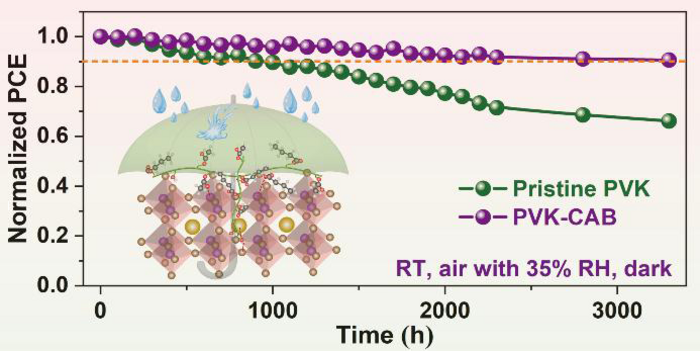Reviewed by Mila PereraOct 26 2022
The Journal of Energy Chemistry recently published an article by Junyou Yang, Yubo Luo, and Xin Li from Huazhong University of Science and Technology and the National University of Singapore titled “Enhancing the stability of planar perovskite solar cells by green and inexpensive cellulose acetate butyrate.”
 Functional groups of cellulose acetate butyrate (CAB) interact with anions and cations in perovskite (PVK) to significantly improve the device stability by inhibiting the decomposition of perovskite. Image Credit: Journal of Energy Chemistry
Functional groups of cellulose acetate butyrate (CAB) interact with anions and cations in perovskite (PVK) to significantly improve the device stability by inhibiting the decomposition of perovskite. Image Credit: Journal of Energy Chemistry
Due to their variable bandgap, high optical absorption coefficient, solution processability, and long carrier diffusion channel, which facilitate low-cost mass production, hybrid organic-inorganic halide perovskite materials are drawing significant attention.
Using conventional (n-i-p) structures, single-junction perovskite solar cells (PSCs) have recently attained a state-of-the-art power conversion efficiency (PCE) of 25.7%.
PSC stability, however, continues to fall short of industry norms. Due to environmental factors such as oxygen concentration, humidity, ultraviolet (UV) sunlight, heat, and electric field, the light-absorbing layer of PSCs is vulnerable to irreversible deterioration.
The numerous flaws in the perovskite layer are the leading cause of its degradation, which impairs device performance by causing nonradiative recombination.
To improve efficiency and device stability, it is crucial to create a high-quality perovskite with minimal flaws that can promote carrier movement at the interface between the perovskite and charge transport layer.
A superior perovskite thin film was created using cellulose acetate butyrate (CAB), a green and affordable organic additive. Compared to the pristine film, the optimized perovskite film had a carrier lifetime of approximately ten times longer.
The energy level and stability of the optimized perovskite films were improved, resulting in the fabrication of an optimized CAB-based device with a superior efficiency of 21.5% compared to the control device (18.2%).
Additionally, after aging for 3300 hours at a relative humidity of 35%, the improved device could maintain an initial efficiency of more than 90%.
Journal Reference
Xiao, B., et al. (2022) Enhancing the stability of planar perovskite solar cells by green and inexpensive cellulose acetate butyrate. Journal of Energy Chemistry. doi:10.1016/j.jechem.2022.09.039.